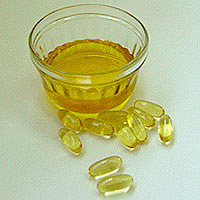Penn Herb Wellness Guide
Polyunsaturated Fats

Varieties
Alpha-linolenic acid (ALA)
ALA is a member of the omega-3 family of fatty acids. It is called an essential fatty acid because the body cannot manufacture it—essential fatty acids must be consumed in the diet. Dietary sources of ALA include flaxseed, soybean, and pumpkin seed oil.
Eicosapentaenoic acid (EPA)
EPA is a member of the omega-3 family of fatty acids. The oils derived from cold-water fish (salmon, tuna, sardines, and cod) are concentrated sources of EPA. To a limited extent, the human body can make EPA from ALA.
Docosahexaenoic acid (DHA)
DHA is a member of the omega-3 family of fatty acids. This fatty acid is found in cold-water fish and in some types of algae.
Linoleic acid
Linoleic acid is a member of the omega-6 family of fatty acids. It is another essential fatty acid. Dietary sources of linoleic acid include sunflower seed, safflower, and corn oil.
Gamma-linolenic acid (GLA)
GLA is a member of the omega-6 family of fatty acids. Borage oil and evening primrose oil are rich sources of GLA.
Copyright 2025 TraceGains, Inc. All rights reserved.
Learn more about TraceGains, the company.
The information presented in the Food Guide is for informational purposes only and was created by a team of USregistered dietitians and food experts. Consult your doctor, practitioner, and/or pharmacist for any health problem and before using any supplements, making dietary changes, or before making any changes in prescribed medications. Information expires December 2025.


